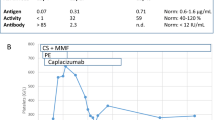Abstract
The development of inhibitory antibodies is the most challenging complication in the management of patients with hemophilia. Although much rarer than the occurrence of inhibitors in hemophilia A, the development of inhibitors in patients with hemophilia B can be complicated by anaphylactoid reactions. Immune tolerance therapy in patients with hemophilia B has a lower success rate than in patients with hemophilia B and can lead to the development of steroid-resistant nephrotic syndrome.
Access this chapter
Tax calculation will be finalised at checkout
Purchases are for personal use only
Similar content being viewed by others
References
Miller CH, Platt SJ, Rice AS, Kelly F, Soucie JM. Validation of Nijmegen-Bethesda assay modifications to allow inhibitor measurement during replacement therapy and facilitate inhibitor surveillance. J Thromb Haemost. 2012;10(6):1055–61.
Barnes C, Davis A, Furmedge J, Egan B, Donnan L, Monagle P. Induction of immune tolerance using rituximab in a child with severe haemophilia B with inhibitors and anaphylaxis to factor IX. Haemophilia. 2010;16(5):840–1.
Darby SC, Keeling DM, Spooner RJD, Wan Kan S, Giangrande PLF, Collins PW, Hill FGH, Hay CRM. The incidence of factor VIII and factor IX inhibitors in the hemophilia population of the UK and their effect on subsequent mortality, 1977-99. J Thromb Haemost. 2004;2(7):1047–54.
Ljung R, Petrini P, Tengborn L, Sjorin E. Haemophilia B mutations in Sweden: a population-based study of mutational heterogeneity. Br J Haematol. 2001;113(1):81–6.
Puetz J, Soucie JM, Kempton CL, Monahan PE. Prevalent inhibitors in haemophilia B subjects enrolled in the Universal Data Collection database. Haemophilia. 2014;20(1):25–31.
Saini S, Hamasaki-Katagiri N, Pandey GS, Yanover C, Guelcher C, Simhadri VL, Dandekar S, Guerrera MF, Kimchi-Sarfaty C, Sauna ZE. Genetic determinants of immunogenicity to factor IX during the treatment of haemophilia B. Haemophilia. 2015;21(2):210–8.
Chitlur M, Warrier I, Rajpurkar M, Lusher JM. Inhibitors in factor IX deficiency a report of the ISTH-SSC international FIX inhibitor registry (1997-2006). Haemophilia. 2009;15(5):1027–31.
Hay CR, DiMichele DM. The principal results of the International Immune Tolerance Study: a randomized dose comparison. Blood. 2012;119(6):1335–44.
DiMichele DM, Kroner BL. Analysis of the North American Immune Tolerance Registry (NAITR) 1993–1997: current practice implications. Vox Sang. 1999;77(Suppl. 1):31–2.
Dioun AF, Ewenstein BM, Geha RS, Schneider LC. IgE-mediated allergy and desensitization to factor IX in hemophilia B. J Allergy Clin Immunol. 1998;102(1):113–7.
Shibata M, Shima M, Misu H, Okimoto Y, Giddings JC, Yoshioka A. Management of haemophilia B inhibitor patients with anaphylactic reactions to FIX concentrates. Haemophilia. 2003;9(3):269–71.
Mathias M, Khair K, Hann I, Liesner R. Rituximab in the treatment of alloimmune factor VIII and IX antibodies in two children with severe haemophilia. Br J Haematol. 2004;125(3):366–8.
Fox RA, Neufeld EJ, Bennett CM. Rituximab for adolescents with haemophilia and high titre inhibitors. Haemophilia. 2006;12(3):218–22.
Curry NS, Misbah SA, Giangrande PLF, Keeling DM. Achievement of immune tolerance in a patient with haemophilia B and inhibitory antibodies, complicated by an anaphylactoid reaction. Haemophilia. 2007;13(3):328–30.
Alexander S, Hopewell S, Hunter S, Chouksey A. Rituximab and desensitization for a patient with severe factor IX deficiency, inhibitors, and history of anaphylaxis. J Pediatr Hematol Oncol. 2008;30(1):93–5.
Chuansumrit A, Moonsup Y, Sirachainan N, Benjaponpitak S, Suebsangad A, Wongwerawattanakoon P. The use of rituximab as an adjuvant for immune tolerance therapy in a hemophilia B boy with inhibitor and anaphylaxis to factor IX concentrate. Blood Coagul Fibrinolysis. 2008;19(3):208–11.
Klarmann D, Martinez Saguer I, Funk MB, Knoefler R, von Hentig N, Heller C, Kreuz W. Immune tolerance induction with mycophenolate-mofetil in two children with haemophilia B and inhibitor. Haemophilia. 2008;14(1):44–9.
Beutel K, Hauch H, Rischewski J, Kordes U, Schneppenheim J, Schneppenheim R. ITI with high-dose FIX and combined immunosuppressive therapy in a patient with severe haemophilia B and inhibitor. Hamostaseologie. 2009;29(2):155–7.
Barnes C, Davis A, Furmedge J, Egan B, Donnan L, Monagle P. Induction of immune tolerance using rituximab in a child with severe haemophilia B with inhibitors and anaphylaxis to factor IX. Haemophilia. 2010;16(5):840–1.
Holstein K, Schneppenheim R, Schrum J, Bokemeyer C, Langer F. Successful second ITI with factor IX and combined immunosuppressive therapy. Hamostaseologie. 2017;34(Suppl 1):S5–8.
Bon A, Morfini M, Dini A, Mori F, Barni S, Gianluca S, de Martino M, Novembre E. Desensitization and immune tolerance induction in children with severe factor IX deficiency; inhibitors and adverse reactions to replacement therapy: a case-report and literature review. Ital J Pediatr. 2015;41:12.
Dharnidharka VR, Takemoto C, Ewenstein BM, Seymour R, William Harris H. Membranous glomerulonephritis and nephrosis post factor IX infusions in hemophilia B. Pediatr Nephrol. 1998;12(8):654–7.
Ewenstein BM, Takemoto C, Warrier I, Lusher J, Saidi P, Eisele J, Ettinger LJ, DiMichele D. Nephrotic Syndrome as a Complication of Immune Tolerance in Hemophilia B. Blood. 1997;89(3):1115–5.
Author information
Authors and Affiliations
Corresponding author
Editor information
Editors and Affiliations
Rights and permissions
Copyright information
© 2020 Springer Nature Switzerland AG
About this chapter
Cite this chapter
Saini, S., Dunn, A.L. (2020). Approach to a Child with Hemophilia B and Anaphylaxis to Factor IX. In: Dunn, A., Kerlin, B., O'Brien, S., Rose, M., Kumar, R. (eds) Pediatric Bleeding Disorders. Springer, Cham. https://doi.org/10.1007/978-3-030-31661-7_4
Download citation
DOI: https://doi.org/10.1007/978-3-030-31661-7_4
Published:
Publisher Name: Springer, Cham
Print ISBN: 978-3-030-31660-0
Online ISBN: 978-3-030-31661-7
eBook Packages: MedicineMedicine (R0)




